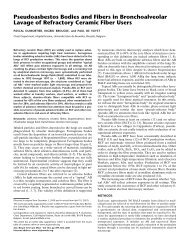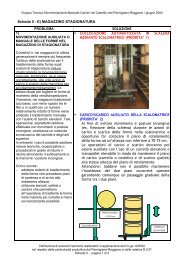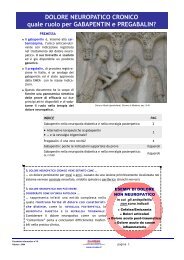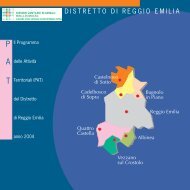Download PDF
Download PDF
Download PDF
- No tags were found...
Create successful ePaper yourself
Turn your PDF publications into a flip-book with our unique Google optimized e-Paper software.
4 J.A. Leis et al.guided by different models or approaches. Such visits maytarget birth or infant outcomes, as well as maternal health,mental health, or parenting skills. Recent reviews of homevisiting programs have found that they have a modest impactin promoting positive parenting behavior and reducing childabuse and neglect (Sweet and Appelbaum 2004). There isrelatively little research regarding the impact of home-basedinterventions, including home visiting, on the prevention andtreatment of PPD.Home-based interventions have considerable potential toaddress PPD effectively for several reasons. First, fewpeople who experience depression seek treatment (Fortneyet al. 1998; U.S. Department of Health and Human Services2001). The Surgeon General’s report on Mental Healthcited treatment-seeking rates as low as 25% in people withdiagnosed disorders (U.S. Department of Health andHuman Services 2001) and rates for low-income, minoritypopulations may be even lower (Miranda et al. 1998).Research suggests that although pregnant women mayinteract with the health care system more than at any othertime in their lives, detection and treatment of depressionremains a problem (Kelly et al. 2001; Lumley et al. 2004;U.S. Department of Health and Human Services 2001).Home-based interventions for women who have recentlydelivered have the potential to introduce mental healthservices to women who do not tend to seek out such services.Second, home-based interventions, particularly homevisiting, typically serve high-risk, low-income familieswho may have the greatest need for mental healthservices yet face significant barriers to obtaining mentalhealth care. The few studies that have examinedprevalence of depression in low-income women showhigher levels of depression among these women comparedto women with greater financial resources (Bennettet al. 2004; Hobfolletal.1995; Holzman et al. 2006).Studies among women of low socio-economic status(SES) have reported depression symptom prevalenceranging from 29 to 51% (Administration for Childrenand Families 2006; McKee et al. 2001; Boltonetal.1998;Da Silva et al. 1998; Seguinetal.1995) and one study oflow SES women found that 16% experienced a majordepressive episode in their second trimester (Hobfoll et al.1995), a prevalence nearly double the pooled prevalencerate for middle-class samples reported by Bennett et al.(2004). This doubling of risk for depression for lowincome,minority perinatal womenwasmirroredinstudiesof women drawn from Women, Infant, and Children(WIC) clinics (Cordero and Kurz 2006; Kurz2005; Kurzand Hesselbrock 2006).Third, home-based programs are a natural place tointegrate the prevention and/or treatment of PPD becausesuch programs already serve large numbers of pregnant andrecently delivered women. Recent years have seen aproliferation in the number of home visiting programs withthis trend likely to continue. There are home visitingprograms in all states; some states have taken specificmodels to scale (e.g., Nurse-Family Partnership, Parents asTeachers, Healthy Families America, Healthy Start), withprograms in nearly every community statewide. Congressrecently considered legislation to expand and improvehome-based parenting services through the EducationBegins at Home Act (U.S. Department of Health & HumanServices 2008).Existing interventions for PPD occurring in the homehave taken one of two approaches: prevention or treatment.Preventive interventions are designed to reduce the developmentof a mental disorder and therefore are implementedbefore the onset of a disorder (Mrazek and Haggery 1994).Within the prevention paradigm, interventions are furtherclassified into three levels which are defined by thepopulations they target: universal, selective, and indicated.Universal preventive interventions target the general populationor a whole population group without regard toindividual risk for a mental disorder, selective preventiveinterventions target individuals or a subgroup of the populationwho have risk factors which increase the likelihoodof developing a mental disorder, and indicated preventiveinterventions target individuals at high risk for developinga mental disorder who have detectable signs or symptoms ofa mental disorder but do not currently meet criteria for adisorder (Mrazek and Haggery 1994). Treatment interventions,on the other hand, target individuals who already meetcriteria for a mental disorder and focus on decreasing theseverity and/or duration of a mental disorder and reducingrisk for future episodes of the disorder.This manuscript reviews what is known about homebasedinterventions’ impact on the prevention andtreatment of PPD. Although three reviews of interventionsto prevent and treat PPD have been published(Dennis and Creedy 2004; Dennis and Hodnett 2007;Lumley et al. 2004), those reviews do not focus specificallyon the impact of home-based interventions on PPD.Given the potential of home-based interventions toaddress PPD and increasing use of home-based interventionsduring the perinatal period, this review provides thefirst in-depth examination of home-based interventions’impact on preventing and treating PPD. We focus ourreview on psychological interventions given researchsuggesting that many mothers prefer non-pharmacologicalinterventions (Dennis and Chung-Lee 2006) and ourbelief that these interventions may have the greatestpotential to impact PPD. Psychological interventionsrefer to an array of structured approaches that incorporatepsychological methods (e.g., cognitive-behavioral therapy,interpersonal psychotherapy) to reduce psychologicaldistress or promote adaptive functioning.
















